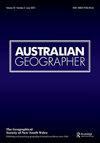作为考古环境的风再加工河道沉积物:澳大利亚东南部第四纪霍克斯伯里-内皮恩序列的阿格尼丝-班克斯沙地
IF 2
2区 社会学
Q2 GEOGRAPHY
引用次数: 0
摘要
摘要 悉尼河流的沉积物被认为在第四纪经历了广泛的风化改造。由此产生的沉积物形成了重要的考古地貌,悉尼地区最古老的考古遗址就位于这些沉积物上。遗憾的是,人们对风化再加工的过程和产物知之甚少。因此,考古发现的背景也就变得扑朔迷离。这项研究的重点是艾格尼丝-班克斯沙地,这是一个新生代沙体,可能是悉尼地区唯一保留了风化过程对河流沉积物作用的可靠证据的沉积单元。我们的研究证实,这些沙体与世界各地的内陆沙丘沉积物没有区别,是由附近尼皮恩河河道内和附近的冲积沉积物再加工而成的。沙粒形成东西对齐的线状沙丘,而沉积物体则向东细化,这种模式与西风的夹带作用相一致。霍克斯伯里-尼皮恩河沿岸还发现了另外三个风化沉积体。这些沙丘共同组成了一个沙丘源边界组合体,位于坎伯兰盆地北部河流的下风向。这里的沉积始于海洋同位素阶段 3-2,一直延续到海洋同位素阶段 1,这一时期与整个澳大利亚东南部的沙丘活化时期相吻合。尽管人们普遍认为阿格尼斯-班克斯沙是在上新世和中更新世之间的某个时期形成的,但我们提出的证据表明,它的沉积时间在 65 ka 之后,并且与流域内的其他流积-风化单元同时存在。然而,艾格尼丝-班克斯的真正重要性在于它是一个典型地点,从这里可以得出沉积学和地貌学的特征,这些特征可用于评估悉尼地区(或许还包括其他地区)的河流-古沉积记录。本文章由计算机程序翻译,如有差异,请以英文原文为准。
Wind-reworked fluvial deposits as an archaeological environment: the Agnes Banks Sand of the Quaternary Hawkesbury–Nepean sequence of southeast Australia
ABSTRACT The deposits of Sydney’s rivers are thought to have experienced widespread aeolian modification during the Quaternary. The resultant sediments form archaeologically important landscapes upon which are found several of the oldest archaeological sites in the Sydney district. Unfortunately, little is known of the processes and products of aeolian reworking. The context of the archaeological discoveries is therefore enigmatic. This study focusses on the Agnes Banks Sand, a Cenozoic sand body that may represent the only sedimentary unit in the Sydney area that preserves reliable evidence of the action of aeolian processes on fluvial sediments. Our work confirms that the sands are indistinguishable from inland dune deposits worldwide, with the deposits reworked from alluvial sediments within and adjacent to the channel of the nearby Nepean River. The sands form east–west-aligned linear dunes, whilst the sediment body fines to the east, a pattern consistent with entrainment by westerly winds. Three other aeolian depositional bodies have been identified alongside the Hawkesbury–Nepean River. Together, these form an assemblage of source-bordering dunes that lies downwind of the river across the northern part of the Cumberland Basin. Deposition here began in Marine Isotope Stages 3–2 and continued into Marine Isotope Stage 1, a period corresponding with a general episode of dune activation across southeast Australia. Although it is widely believed that the Agnes Banks Sand was formed sometime between the Pliocene and the Middle Pleistocene, we present evidence that its deposition post-dates 65 ka and that the deposits are contemporaneous with the other fluvio-aeolian units in the catchment. The true importance of Agnes Banks, however, is as a type locality from which it has been possible to derive sedimentological and geomorphological signatures that may be applied to appraisals of the fluvio-aeolian record within (and perhaps beyond) the Sydney area.
求助全文
通过发布文献求助,成功后即可免费获取论文全文。
去求助
来源期刊

Australian Geographer
GEOGRAPHY-
CiteScore
4.10
自引率
8.30%
发文量
33
期刊介绍:
Australian Geographer was founded in 1928 and is the nation"s oldest geographical journal. It is a high standard, refereed general geography journal covering all aspects of the discipline, both human and physical. While papers concerning any aspect of geography are considered for publication, the journal focuses primarily on two areas of research: •Australia and its world region, including developments, issues and policies in Australia, the western Pacific, the Indian Ocean, Asia and Antarctica. •Environmental studies, particularly the biophysical environment and human interaction with it.
 求助内容:
求助内容: 应助结果提醒方式:
应助结果提醒方式:


